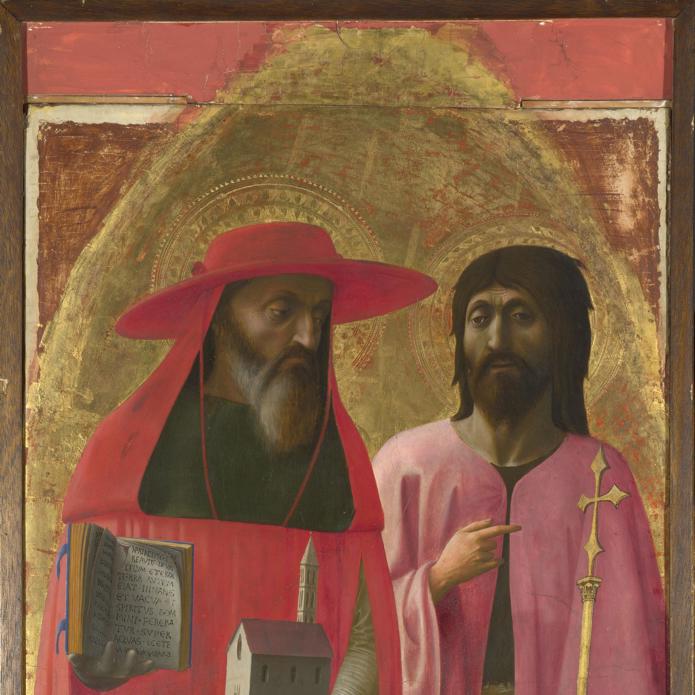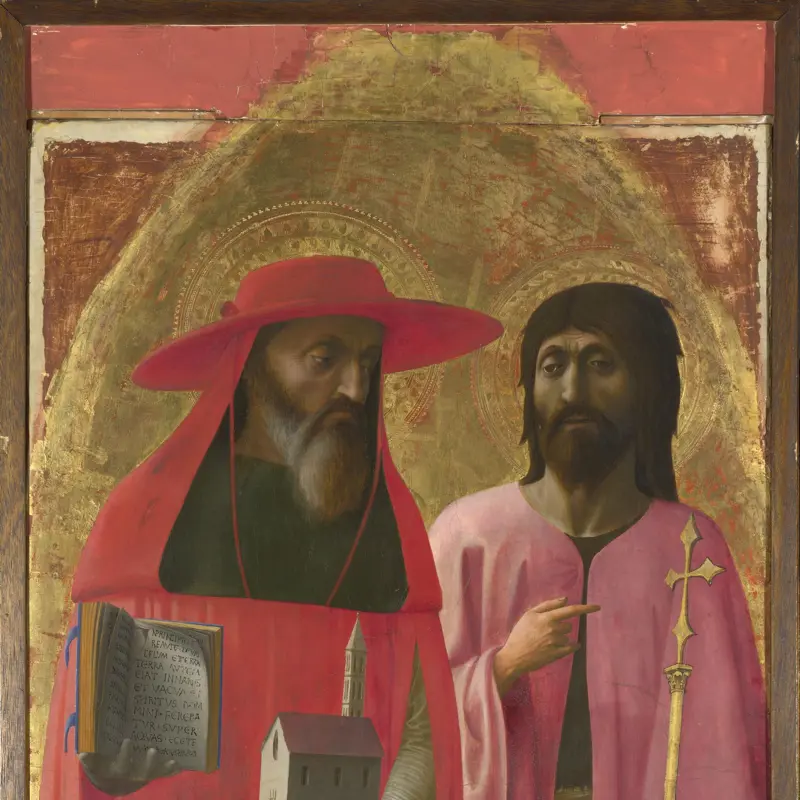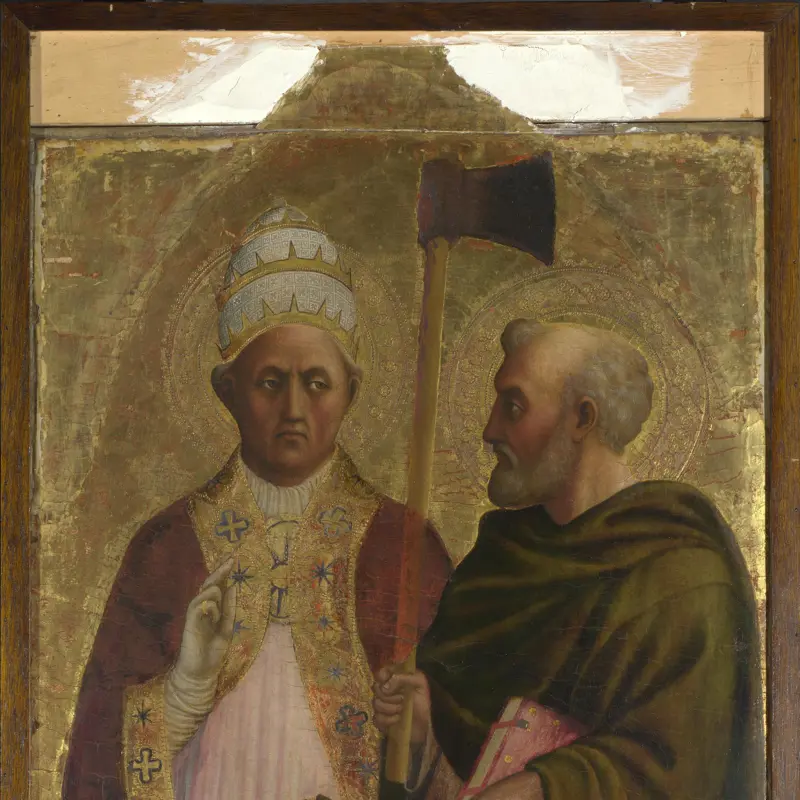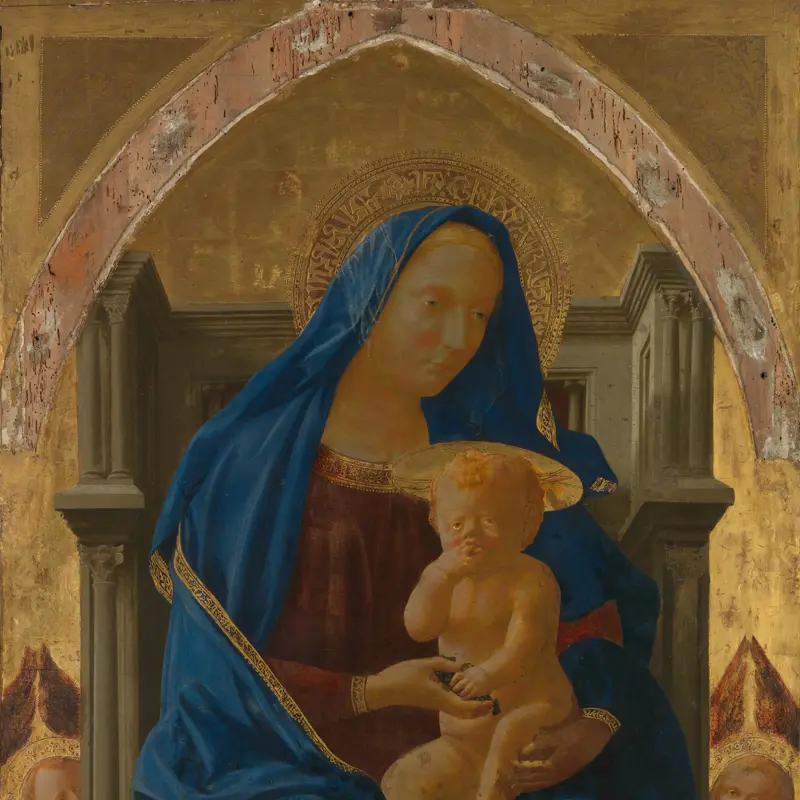Masaccio, 'Saints Jerome and John the Baptist', about 1428-9
About the work
Overview
Saint Jerome, wearing his red cardinal’s hat, and Saint John the Baptist stand side by side on a grassy hillock. Saint John’s sturdy toes interrupt a carpet of wild flowers, including yellow dandelions, violets and strawberries.
A lion sits at Saint Jerome’s feet – according to his legend, when living as a monk near Bethlehem Jerome pulled a thorn from a lion’s foot; it then became his companion. John the Baptist is shown in the camel-hair tunic that he wore when he was in the wilderness, preaching and baptising people in the river Jordan. His preached about Christ and his significance, and so he carries a cross and a scroll with the words he spoke about Christ: ‘Behold! The Lamb of God.’
The panel comes from a large double-sided altarpiece that Masolino and Masaccio collaborated on for the church of Santa Maria Maggiore. This panel is by Masaccio, but Masolino had to complete the altarpiece after the artist’s death in 1428/9.
Key facts
Details
- Full title
- Saints Jerome and John the Baptist
- Artist
- Masaccio
- Artist dates
- 1401 - 1428/9?
- Part of the series
- Santa Maria Maggiore Altarpiece
- Date made
- About 1428-9
- Medium and support
- Egg tempera on wood (poplar, identified)
- Dimensions
- 125 × 58.9 cm
- Acquisition credit
- Bought with a contribution from the Art Fund, 1950
- Inventory number
- NG5962
- Location
- Room 57
- Collection
- Main Collection
- Frame
- 20th-century Replica Frame
Provenance
Additional information
Text extracted from the ‘Provenance’ section of the catalogue entry in Dillian Gordon, ‘National Gallery Catalogues: The Fifteenth Century Italian Paintings’, vol. 1, London 2003; for further information, see the full catalogue entry.
Exhibition history
-
2014Making ColourThe National Gallery (London)18 June 2014 - 7 September 2014
-
2022Donatello, the RenaissanceVictoria and Albert Museum11 February 2023 - 11 June 2023
Bibliography
-
1878G. Vasari, Le vite de'più eccellenti pittori, scultori ed architettori: Con nuove annotazioni e commenti di Gaetano Milanesi, ed. G. Milanesi, 8 vols, Florence 1878
-
1930L. Venturi, 'Contributi a Masolino', L'arte, XIII, 1930, pp. 165-79
-
1943J. Pope-Hennessy, 'A Predella Panel by Masolino', The Burlington Magazine, LXXXII, 1943, pp. 30-1
-
1951Davies, Martin, National Gallery Catalogues: The Earlier Italian Schools, London 1951
-
1951U. Procacci, Tutta la pittura di Masaccio, Milan 1951
-
1951K. Clark, 'An Early Quattrocento Triptych from Santa Maria Maggiore, Rome', The Burlington Magazine, XCI/584, 1951, pp. 339-47
-
1952R. Longhi, 'Presenza di Masaccio nel trittico della Neve', Paragone, XXV, 1952, pp. 8-16
-
1952M. Meiss, 'London's New Masaccio', Art News, 1952
-
1952J. Pope-Hennessy, 'Letter: The Santa Maria Maggiore Altarpiece', The Burlington Magazine, XCIV/586, 1952, pp. 31-2
-
1952M. Salmi, 'Gli scomparti della pala di Santa Maria Maggiore acquistati dalla National Gallery', Commentari, 1952, pp. 14-21
-
1953U. Procacci, 'Sulla cronologia delle opere di Masaccio e di Masolino tra il 1425 e il 1428', Rivista d'arte, 1953, pp. 3-55
-
1955The National Gallery, The National Gallery: 1938-1954, London 1955
-
1959F. Hartt, 'The Earliest Works of Andrea del Castagno', Art Bulletin, 1959, pp. 159-81
-
1962D. Gioseffi, 'Domenico Veneziano: L'esordio masaccesco e la tavola con i SS. Gerolamo e Giovanni Battista della National Gallery di Londra', Emporium, CXXXV, 1962, pp. 51-72
-
1962U. Middeldorf, 'Un Rame Inciso del Quattrocento', in V. Martinelli and F.M. Aliberti Gaudioso (eds), Scritti di Storia dell'arte in onore di Mario Salmi, Rome 1962, vol. 2, pp. 273-89
-
1963B. Berenson, Italian Pictures of the Renaissance: A List of the Principal Artists and Their Work, with an Index of Places: Florentine School, 2 vols, New York 1963
-
1964M. Meiss, 'The Altered Program of the Santa Maria Maggiore Altarpiece', in Studien zur Toskanischen Kunst, München 1964, pp. 169-90
-
1965L. Vayer, 'Analecta iconographica masoliniana', Acta historiae artium, XI, 1965, pp. 217-39
-
1980H. Wohl, The Paintings of Domenico Veneziano, ca. 1410-1461: A Study in Florentine Art of the Early Renaissance, Oxford 1980
-
1980A. Braham, 'The Emperor Sigismund and the Santa Maria Maggiore Altar-Piece', The Burlington Magazine, CXXII/923, 1980, pp. 106-12
-
1986Davies, Martin, National Gallery Catalogues: The Earlier Italian Schools, revised edn, London 1986
-
1987M. Boskovits, 'Il percorso di Masolino precisazione sulla cronologia e sul catalogo', Arte Cristiana, 718, 1987, pp. 47-66
-
1987C.B. Strehlke and M. Tucker, 'The Santa Maria Maggiore Altarpiece: New Observations', Arte Cristiana, 719, 1987, pp. 105-24
-
1988P. Joannides, 'The Colonna Triptych by Masolino and Masaccio: Collaboration and Chronology', Arte Cristiana, LXXVI, 1988, pp. 339-46
-
1989L. Berti and R. Foggi, Masaccio: Catalogo completo dei dipinti, Florence 1989
-
1991K. Christiansen, 'Some Observation on the Brancacci Chapel Frescoes after Their Cleaning', The Burlington Magazine, CXXXIII/1054, 1991, pp. 4-20
-
1993P. Joannides, Masaccio and Masolino: A Complete Catalogue, London 1993
-
1993P.L. Roberts, Masolino da Panicale, Oxford 1993
-
2001
C. Baker and T. Henry, The National Gallery: Complete Illustrated Catalogue, London 2001
-
2003Gordon, Dillian, National Gallery Catalogues: The Fifteenth Century Italian Paintings, 1, London 2003
-
2004P. Nuttall, From Flanders to Florence: The Impact of Netherlandish Painting, 1400-1500, New Haven 2004
Frame
This is a twentieth-century replica frame, probably made at the Gallery. Crafted from pinewood, it features a partially ebonised Roman-style moulding with a gilded reel on the outward-curved top moulding. It is fitted with a gilt Gothic arched slip frame. The inner mouldings and spandrels have a craquelure finish, and are water-gilded to match the gilding on Masaccio’s Saints Jerome and John the Baptist.
This is one of two panels, framed as a pair, which were originally part of a double-sided triptych from the basilica of Santa Maria Maggiore in Rome.
About this record
If you know more about this work or have spotted an error, please contact us. Please note that exhibition histories are listed from 2009 onwards. Bibliographies may not be complete; more comprehensive information is available in the National Gallery Library.
Images
About the series: Santa Maria Maggiore Altarpiece

Overview
The Florentine painters Masaccio and Masolino often collaborated on large-scale projects. These panels come from a double-sided altarpiece made for the church of Santa Maria Maggiore in Rome. It was placed in the canon’s choir and probably commissioned by the wealthy and notable Colonna family.
One side would have been visible to only the canons – the clergymen connected specifically to the church and bound by its rules – who worshipped in this chapel and the other side to all who prayed in the church. The chapel was dedicated to Saint John the Baptist which explains his presence with Saint Jerome on the panel by Masaccio, Saints Jerome and John the Baptist. The painting by Masolino, A Pope (Saint Gregory?) and Saint Matthias, was once on the other side of the same panel. Masolino completed the altarpiece after Masaccio died in Rome of the plague in 1428/9.



